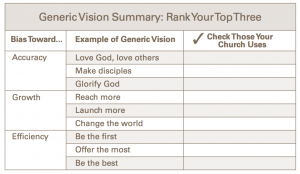
Understanding the Four Horizons of Vision
Do you really understand visionary planning?
As a leader, can you clarify the difference between having a vision and having a plan? Vision is about the picture of your church’s future. A plan is about the steps to get there.
The vision answers the question, “Where is God taking us?” The plan answers the question, “What are the next best steps, and how do they relate?”
Solution – Understanding the Four Horizons of Vision
THE QUICK SUMMARY – God Dreams by Will Mancini
Is your team excited about the next big dream for your church?
You are a visionary leader and your church probably has a vision statement. Yet most churches are stuck in a trap of generic communication without a truly visionary plan. Just like a visionary restaurant needs a more specific focus than “serving food,” a visionary church needs something more than biblical generalizations like “loving God, loving people” or “making disciples and serving the world.”
When a team doesn’t share an understanding of God’s next big dream, leadership grows tired, overworked by an “all things to all people” ministry approach. Too often there’s no unified picture of what success looks like. People can feel uninspired and your church’s programming can seem more optional than ever.
Ministry without clarity is insanity. Are you ready for a better way?
In this groundbreaking work, based on Will Mancini’s 15 years and over 10,000 hours of church team facilitation, God Dreams reveals a simple and powerful planning method that will bring energy and focus to your church like never before.
First, God Dreams shows how to reclaim the role of long-range vision today by providing 12 vision templates, each with biblical, historical, and contemporary illustrations. These vision starters will dramatically accelerate your team’s ability to find complete agreement regarding your church’s future.
Second, God Dreams explains how to overcome the fruitless planning efforts that many church teams experience. With a tool called the Horizon Storyline, leaders can connect short-term action steps with the long-range dream, while leveraging the power of storytelling to make the plan “stick.” This tool will galvanize a diverse team of ministry leaders and volunteers with unprecedented enthusiasm.
Imagine leading with a refreshed sense of freedom and confidence, with a totally new way to inspire your church. Imagine the ability to harness the energy and resources of your people toward a specific dream of gospel impact, in your church and in your lifetime.
God Dreams is your passport to leading into a better future.
A SIMPLE SOLUTION
Your eyes can focus on multiple horizons. As you are reading this document, look up and notice what is in your midground – a desk and chairs, other people?
Now look to the background and note what you see. A window to look through or a bookshelf?
The document itself and your arms and hands are in your foreground.
Without moving your head, experience the ability to focus in and out of these three horizons going back and forth quickly. That’s called accommodation. It’s a natural reflex that is happening subconsciously all day long. But it’s also a voluntary process. You can consciously control it whenever you want, as you probably did while trying the exercise.
What’s natural to your daily life can also be natural to your church’s organizational life. It is possible to use the three basic distances you are zooming in and out of all day long to build a visionary planning model.
In fact, the primary reason for vision in human-body functions is to guide and direct movement. The same might be said of your visionary plan: it exists to guide and direct movement for the church body as a whole.
The Horizon Storyline is a tool to develop the right amount of vision content for the right time in the future, for the entire leadership team.
The breakthrough of the Horizon Storyline is the development of a planning tool that fits human experience. It’s natural to grasp, using the way we already see, think, and communicate. What if we could forever remove the “it’s just too complicated” barrier? What if your planning tool would intuitively and immediately make sense? What if it would actually be fun to revisit over and over again?
The Horizon Storyline is defined by how we see different “horizons” in our field of vision every day. This idea is illustrated in a landscape painting, with the background far away as the eyes can see; a focal point of the piece in the midground that draws and keeps your focus; and an object in the foreground up close, right before your eyes.
To start, we just carry over the simple idea of background, midground, and foreground using those as names for three of our four planning horizons. We will simply see them as horizons, not in three-dimensional space but into the future. They are time horizons.
Here’s how it works. The near future we will define as ninety days away. That is the foreground vision. The next horizon, the midground vision, we define as one year away. And the furthest horizon we can “see” as an organization is the background vision, defined as three years away. The eyes of your church or ministry should be able to “see” this amount of time into the future.
Now that leaves one more horizon to define. This fourth horizon is just a little farther than you can clearly see. It’s just past your visible range. I call that “beyond the horizon” as a reminder that it is far away, just over the next mountain range, so to speak. I define this time frame as anywhere between five and twenty years depending on the church’s life stage and context.
Will Mancini, God Dreams
A NEXT STEP
The horizons described above are extensions of the way your eyes naturally work.
Right now think of at least one foreground, or short-term strategic horizon for your church. Something within the next 60-90 days.
Now list one big thing you hope to accomplish in the next year.
Finally, what is a big project, idea or task that you know will need to be tackled in the next few years of your leadership?
Rate the connectedness and continuity between these strategic initiatives. Bring the team together and ask, what could be done to bring these three natural horizons of visionary planning into alignment?
More energy. Greater resources. Better synergy. Would you like to have that right now at your church? Would you have guessed that the first step toward these improvements is defining your specific vision as a church?
If you don’t have a clear vision, you certainly won’t have a culture that matches. And if you don’t have a strong culture, then what are people in your church really doing?
Why are they there?
Taken from SUMS Remix 32-2, published January 2016
This is part of a weekly series posting content from one of the most innovative content sources in the church world: SUMS Remix Book Summaries for church leaders. SUMS Remix takes a practical problem in the church and looks at it with three solutions; and each solution is taken from a different book. As a church leader you get to scan relevant books based on practical tools and solutions to real ministry problems, not just by the cover of the book. Each post will have the edition number which shows the year and what number it is in the overall sequence. (SUMS provides 26 issues per year, delivered every other week to your inbox).

Tags: God Dreams, Horizon Storyline, Visionary Planning, Will Mancini




























